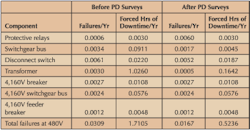After three 4,160V dry type transformers failed at a 30-yr-old hospital over a three-year period, the hospital's facility manager contacted the transfomer's manufacturer, who informed him the transformers were reaching the end of their life expectancy and would continue to fail. Lacking the cash flow and other significant financial resources to replace every transformer, the hospital implemented a partial discharge testing (PDT) program, allowing them to prioritize replacement. Two transformers had critical partial discharge levels, so the hospital replaced those immediately. Three other transformers had only moderate partial discharge levels, and the hospital is trending those for insulation deterioration. PDT showed the remaining 12 transformers were in good condition.
Shortly after implementing a PDT program on its aging 16.5kV cable system, a municipality discovered several problems, including 13 cable terminations, two splices, and one cable circuit with critical levels of partial discharge. The utility repaired the problems, avoiding emergency outages in the process. The tests uncovered moderate levels of partial discharge activity in several other components, so the utility is monitoring them for deterioration trends.
During its first PDT, a chemical plant found extremely high partial discharge activity on a 12.47kV load interrupter switch. The testing firm advised the facility directors to immediately remove the circuit from service. However, production schedules made that unfeasible. Although an insulator on the switch failed within a week and the facility's maintenance team was unable to stop it, early warning allowed the owners to bring repair materials to the site before the failure occurred, saving several critical hours of downtime.
In each of these cases the owners saved significant time and money by using this technology. If budgetary constraints and other limitations at your facility are straining your maintenance capabilities, partial discharge testing can provide welcome relief.
Understanding partial discharge testing
To understand what PDT is about, you first need to understand what “partial discharge” means. A partial discharge is an electrical spark that bridges a portion of the insulation between energized conductors in a dielectric. It doesn't necessarily occur at either of the conducting bodies. It can occur anywhere the electric field strength exceeds the breakdown strength of that portion of the dielectric material. This is due to imperfections, voids, contaminants, cracks, and other irregularities in the dielectric.
Partial discharges typically occur at 2,000V or greater and are measured in units of charge called picoCoulombs (pC). Most electrical equipment, including transformers, switchgear and cables, is free of partial discharge when it leaves the factory floor. Cables may have some negligible discharge. Partial discharges create small impulses in the nanosecond range. A partial discharge test instrument can detect the impulse in the field by using capacitive and inductive sensors. It then processes the analog signals through a network of noise filters, amplifiers, and analog-to-digital converters. As equipment ages, though, dielectrics begin to break down and ultimately fail. So PDT is a reliable indicator of equipment condition.
For many years, laboratories have performed PDT on medium- and high-voltage components for quality assurance purposes. The technology has more recently been useful as a diagnostic tool for field measurements to detect impending insulation failure. PDT is now a recognized method of increasing electrical reliability for electrical installations — whether new or existing. The Sidebar below gives examples of the kinds of equipment you can test with this technology. PDT is:
- Predictive — It indicates specific symptoms in advance of failure.
- Nonintrusive — It requires no interruption of service or change from normal operating voltage
- Nondestructive — It doesn't test to failure or adversely affect the equipment under test.
- Minimal stress — It doesn't need to use overvoltages, which expose the tested equipment to higher voltage stresses than those encountered under normal operating conditions.
- Trending-oriented — You can store results to compare with future tests.
- Localization-enabled — It often allows locating the site of the partial discharge occurrence within the test object, facilitating repairs.
- Inexpensive — It allows for performing annual surveys economically at most facilities.
Often field insulation tests of existing equipment produce very little or no partial discharges, which shows the insulation system is in good condition and will not require another test for one year. If you have equipment with moderate amounts of partial discharge, you can trend it to determine insulation deterioration rates. This allows you to schedule corrective actions before failure occurs. If you discover critical levels of partial discharge, you must take immediate corrective actions. The top priority of performing PDT at a facility for the first time is to identify these dangerous conditions.
Partial discharge analysis works well for all types of medium- or high-voltage equipment (Table above), but it's an extremely important condition assessment tool for cables. Preventive maintenance programs often ignore cables. This is partly due to the inability of any convenient field test to produce meaningful results and partly due to the common fear of damaging the cables. Since PDT does not require an outage and reliably assesses cable insulation condition, this test is especially suited for predicting cable failure.
PDT helps predict failures if you trend the results, and it helps prevent failures if you take preventive measures based on what you see. A well-implemented PDT program can significantly enhance electrical reliability.
Sidebar: Examples of Equipment You Can Test
- Cables, terminations, and splices
- Instrument transformers: potential, current, ccpds
- Power transformers and bushings
- Motors and generators
- Switchgear
- Surge arrestors
- Capacitors
